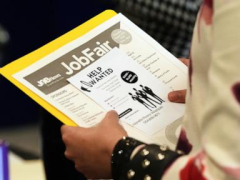WASHINGTON — When Carly Kaprive left a job in Kansas City and moved to Chicago a year ago, she figured it would take three to six months to find a new position. After all, the 32-year old project manager had never been unemployed for longer than three months.
Instead, after 700 applications, she’s still looking, wrapped up in a frustrating and extended job hunt that is much more difficult than when she last looked for work just a couple of years ago. With uncertainty over interest rates, tariffs, immigration, and artificial intelligence roiling much of the economy, some companies she’s interviewed with have abruptly decided not to fill the job at all.
“I have definitely had mid-interview roles be eliminated entirely, that they are not going to move forward with even hiring anybody,” she said.
Kaprive is caught in a historical anomaly: The unemployment rate is low and the economy is still growing, but those out of work face the slowest pace of hiring in more than a decade. Diane Swonk, chief economist at KPMG, calls it a “jobless boom.”
While big corporate layoff announcements typically grab the most attention, it has been the unwillingness of many companies to add workers that has created a more painful job market than the low 4.3% unemployment rate would suggest. It is also more bifurcated: The “low hire, low fire” economy has meant fewer layoffs for those with jobs, while the unemployed struggle to find work.
“It’s like an insider-outsider thing,” Guy Berger, head of research at the Burning Glass Institute said, “where outsiders that need jobs are struggling to get their foot in, even as insiders are insulated by what up until now is a low-layoff environment.”
Several large companies have recently announced tens of thousands of job cuts in the past few weeks, including UPS, Target, and IBM, though Berger said it is too soon to tell whether they signal a turn for the worse in the economy. But a rise in job cuts would be particularly challenging with hiring already so low.
For now, it’s harder than ever to get a clear read on the job market because the government shutdown has cut off the U.S. Department of Labor’s monthly employment reports. The October jobs report was scheduled for release Friday but has been delayed, like the September figures before it. The October report may be less comprehensive when it is released because not all the data may be collected.
Before the shutdown, the Labor Department reported that the hiring rate — the number of people hired in a given month, as a percentage of those employed — fell to 3.2% in August, matching the lowest figure outside the pandemic since March 2013.
Back then, the unemployment rate was a painful 7.5%, as the economy slowly recovered from the job losses from the 2008-2009 Great Recession. That is much higher than August’s 4.3%.
Many of those out of work are skeptical of the current low rate. Brad Mislow, 54, has been mostly unemployed for the past three years after losing a job as an advertising executive in New York City. Now he is substitute teaching to make ends meet.
“It is frustrating to hear that the unemployment rate is low, the economy is g





